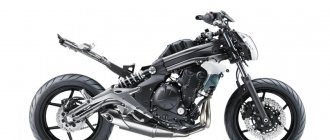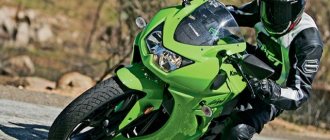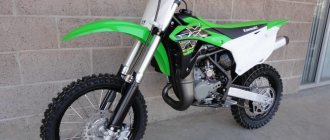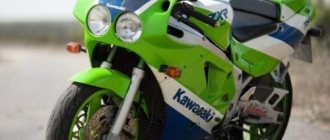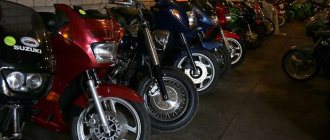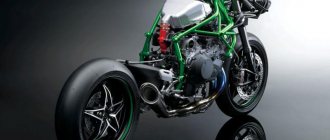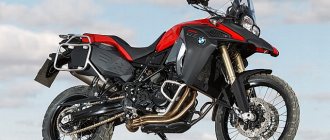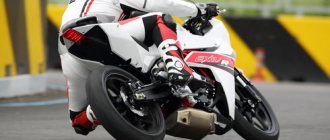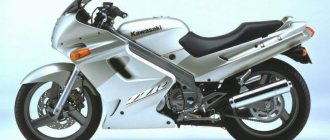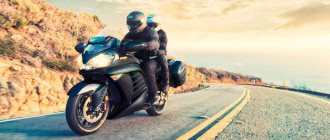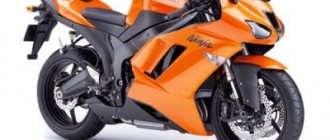The class of 600 cc motorcycles can be called perhaps the most popular in the modern world, and the Kawasaki ER 6N is its prominent representative. This motorcycle has long won popular love thanks to its good combination of affordable price and good technical characteristics. Indeed, you can buy a used Kawasaki EP6N for a moderate amount - prices on the secondary market start at about 200 thousand rubles. There are cheaper options, but you need to inspect them doubly carefully, as there is a high chance of running into a “killed bike.” However, in the fall, really lucrative offers often appear, when motorcyclists rush to change their equipment; many do this almost every year.
How Kawasaki took over city streets
What should you offer customers to lure them away from competitors? That's right - a good product at a good price. Having bet on the Kawasaki EP6, the Japanese were right - the inexpensive, moderately powerful and generally attractive bike quickly won the audience award. What distinguishes it from most other 600 cc road cars is, first of all, the engine – an in-line “two” instead of the usual “four”. At the same time, the Kawasaki ER 6N has good technical characteristics, and the main advantage of its engine is that it does not need to be “twisted”. The engine, which is less boosted than the inline-four, feels very peppy at low and medium speeds, and accelerates the motorcycle very smoothly. The Kawasaki EP6N engine turned out to be so good that it subsequently, in a slightly modified form, served as the basis for the touring enduro Kawasaki Versys 650. At the same time, the hero of our article differs from the ER 6F model (aka Ninja 650R) mainly in the absence of a plastic body kit, representing a classic modern naked bike.
At first glance, the Kawasaki ER 6N has rather modest technical specifications - 72 hp. and 64-66 Nm of torque depending on the year of manufacture. However, thanks to a well-chosen gear ratio in the 6-speed gearbox and a weight of about 200 kg, the motorcycle turned out to be very peppy. The Kawasaki EP6 accelerates from 0 to 100 km/h 3.8 seconds , which is comparable to the results of more powerful 600s with 4-cylinder engines. The undoubted advantages of the bike include its obedient nature. If you look at the torque curve, you'll find a flat graph with no kicks or dips, so you shouldn't expect any unexpected surprises from the ER 6N. On the other hand, a sharp opening of the throttle instantly teleports the bike to the desired point. This, probably, is partly the reason for the commercial success of this model - the Kawasaki EP6N turned out to be equally well suited for both beginners and experienced bikers.
The suspension he got, of course, was simple - a 41-mm telescopic fork in front, a classic pendulum with preload adjustment in the . The brakes also lack stars from the sky - two 300 mm discs with 2-piston calipers at the front and a 220 mm disc with a 1-piston caliper at the rear . The effectiveness of the braking system can be rated 4 points on a 5-point scale, but the situation is improved by the ABS system , which was offered as an additional option during the release years of the Kawasaki ER 6N.
Outside the window, the temperature has remained below zero for almost the third week, it snows periodically and the roads are covered with ice. Winter came to the Urals quite early, just like last year. This means that the season is almost 100% likely already closed, and it’s time, while all the summer events are fresh in your memory, to share your impressions of using your iron horse. And so - at the beginning of July this year, I bought my second Japanese motorcycle. The choice fell on the Kawasaki ER-4N, released according to documents in 2010, although in fact this is the 2011 model series; they were not produced before. Again, as in the case of the TZR, this is a model for the Japanese domestic market; only the ninja 400 (plastic version) was exported and, if I’m not mistaken, sold in Canada. During our short summer, I managed to drive less than 2000 km, for some this is not a distance at all, but I mostly went only to/from work + small rides around the city, so there was nowhere to get a huge mileage. However, I managed to fully drive along the highway, more than 100 km one way, and through city traffic jams, and even off-road, on which endurists stood up - for this reason I think that I can tell you something useful.
Some technical characteristics Engine: Liquid-cooled, 4-stroke, parallel (in-line) twin, DOHC, 4 valves per cylinder, volume 399 cc; Fuel supply system: Injector, ø34 mm x 2 from Keihin; Power\torque: 44 hp\37nm; Transmission: 6 speeds, chain drive; Suspension: front – simple telescope 41mm, fork travel 120mm; rear — mono shock absorber, 120mm travel, preload adjustment; Brakes: front - two 300mm petal floating discs, 2-piston calipers; rear - one 220mm petal disc, single-piston caliper; Seat height: 785mm; Weight: about 200kg. To summarize, everything except engine size is identical to the older ER-6N of the same year.
First look In the photo from the JBA auction site, he appeared like this. And no matter how stupid it may sound, I was hooked by his appearance! The signature Kawasaki color (yes, yes, it’s not just green) candy plasma blue is more than just blue, in the sun it’s a very beautiful and deep color. A neat muffler under the frame, a tubular frame itself with a complex-shaped swingarm, sporty features of the tail and tank, a comfortable saddle, a wide rear wheel! The only thing missing were clip-ons and a reversible fork)) It’s not that I haven’t seen Ershiki before, but compared to the first generation (before 2009), their appearance has definitely improved. I got it with a mileage of 7383 km and judging by the condition, this was quite true. Auction rating 4 points, external traces of use can be said to be absent, there were no scratches or abrasions even on the footrests, shod in Dunlop Sportmax as if it had just come from the store. In general - yum! Maybe the chain is a little wobbly, but that was solved by cleaning and lubricating it. Also, the lack of mileage on the mainland, and me as the first owner, created the impression that the motor was like new.
General impression I switched to a mini brush from my Yamaha tzr, which weighed 120 kg with a full tank - and the first thing I noticed was that the brush is incredibly HEAVY! The difference in weight is already felt when you sit in the saddle and hold the bike horizontally. But the almost 2-fold superiority in mass makes itself felt when you try to push it up the slightest hill or hill. The center of gravity is quite high, despite the fact that the engine is low and the exhaust is also level at the bottom. You don’t feel it while driving, but in static conditions it’s 200 kg of iron. Unless you are tall and weigh at least half a motorcycle, it will definitely be heavy for you. On the other hand, being 187cm tall, it’s very comfortable for me, the bike doesn’t feel overly small, my arms and legs are exactly where they need to be, the seating position is not completely level, with a slight shift towards the tank and handlebars, my back doesn’t get tired, I can hold on to the tank with my knees , in general I like it. This was the second factor in favor of the purchase - it is comfortable.
Driving characteristics Despite the fact that the brush is almost 4 times more powerful than my previous tzr, it is not perceived as a racing car against a bicycle. It has a very smooth and, in my opinion, linear response to the throttle; it goes exactly as far as you unscrew it. There are no failures, no catches - he just smoothly but confidently begins to move forward. It confidently drives 5 mph at idle with the throttle closed. The engine spins up to 13 thousand, around 5 thousand there are some increased vibrations, which are less pronounced at other speeds. If you don’t look at the tachometer and focus on the sound, then shifts usually occur around 7-8 thousand revolutions, it seems that you’ve already turned up the gear - but in fact there is still room for improvement. In general, you can shift to 5 thousand, the engine has excellent traction, and you can easily move off in 2nd gear. Also, when driving at medium speeds, a sharp opening of the gas allows you to quickly accelerate, the response is excellent - the only thing is that you quickly hit the end of the gear and you have to click the gearbox. Therefore, the objective difference between 400 and, say, 600 will be that up to 100 km/h from a standstill I need to change gears twice, but at a larger cubic capacity I can drive away in first gear. But when driving around the city in 80-90 mode there are no difficulties; I never turned it higher than 3rd. The maximum speed to which I accelerated on it was about 150 km/h according to the speedometer. I just didn’t try anymore, the bike was riding confidently and faster, but I was frankly scared - the resistance of the oncoming flow was so great that it blew me out of the saddle and I had to cling to the steering wheel with all my strength with my hands and the tank with my knees. I held out for literally 30 seconds and slowed down. Aerodynamics on a naked road bike is clearly not its strong point. Perhaps a minimal windshield will improve the situation, but without it, above 120 on the highway it’s frankly not comfortable. But it steers well - changing lanes at high speed is done with ease, it goes exactly where it thought and looked. At low speed it is also very stable and does not try to fall anywhere. Very often I crawl up to a traffic light and catch it with the steering wheel at about 0 speed so as not to completely stop a couple of seconds before the traffic light. I could easily complete the “slow square” exercise from the practical exam for the category. The suspension is moderately energy-intensive, on bumps it naturally shakes but does not break through - I happened to drive on a dirt road with traces of bombing, no differently, as there are continuous holes up to 10 cm deep, you can crawl across, the spine was not damaged. Moderate unevenness in the city also does not cause problems, but the quality of the surface under the wheels always gives feedback. Over 100 km in one direction, my limbs don’t go numb, my back doesn’t hurt—I haven’t tried driving further yet. Brakes - taking into account the fact that they are identical to those on the ER6, they are more than sufficient in all respects.
It has a very smooth and, in my opinion, linear response to the throttle; it goes exactly as far as you unscrew it. There are no failures, no catches - he just smoothly but confidently begins to move forward. It confidently drives 5 mph at idle with the throttle closed. The engine spins up to 13 thousand, around 5 thousand there are some increased vibrations, which are less pronounced at other speeds. If you don’t look at the tachometer and focus on the sound, then shifts usually occur around 7-8 thousand revolutions, it seems that you’ve already turned up the gear - but in fact there is still room for improvement. In general, you can shift to 5 thousand, the engine has excellent traction, and you can easily move off in 2nd gear. Also, when driving at medium speeds, a sharp opening of the gas allows you to quickly accelerate, the response is excellent - the only thing is that you quickly hit the end of the gear and you have to click the gearbox. Therefore, the objective difference between 400 and, say, 600 will be that up to 100 km/h from a standstill I need to change gears twice, but at a larger cubic capacity I can drive away in first gear. But when driving around the city in 80-90 mode there are no difficulties; I never turned it higher than 3rd. The maximum speed to which I accelerated on it was about 150 km/h according to the speedometer. I just didn’t try anymore, the bike was riding confidently and faster, but I was frankly scared - the resistance of the oncoming flow was so great that it blew me out of the saddle and I had to cling to the steering wheel with all my strength with my hands and the tank with my knees. I held out for literally 30 seconds and slowed down. Aerodynamics on a naked road bike is clearly not its strong point. Perhaps a minimal windshield will improve the situation, but without it, above 120 on the highway it’s frankly not comfortable. But it steers well - changing lanes at high speed is done with ease, it goes exactly where it thought and looked. At low speed it is also very stable and does not try to fall anywhere. Very often I crawl up to a traffic light and catch it with the steering wheel at about 0 speed so as not to completely stop a couple of seconds before the traffic light. I could easily complete the “slow square” exercise from the practical exam for the category. The suspension is moderately energy-intensive, on bumps it naturally shakes but does not break through - I happened to drive on a dirt road with traces of bombing, no differently, as there are continuous holes up to 10 cm deep, you can crawl across, the spine was not damaged. Moderate unevenness in the city also does not cause problems, but the quality of the surface under the wheels always gives feedback. Over 100 km in one direction, my limbs don’t go numb, my back doesn’t hurt—I haven’t tried driving further yet. Brakes - taking into account the fact that they are identical to those on the ER6, they are more than sufficient in all respects.
Maintenance costs I always fill up with 95 liters - I couldn’t fill the tank with more than 12 liters, the full volume is stated at 15, I’ve never run it down to 0. If you turn the engine, it consumes gasoline very actively, it may well gobble up all 10 liters per 100 km in the city. Immediately after the purchase, I was sent for service to a kawasaki dealer, where they charged 8,000 rubles and kopecks for changing the oil, checking all components, adding antifreeze and lubricating the chain. A plastic rivet next to the tidy was also ordered - for some reason one was missing, 124 rubles for the original one. Subsequently, I noticed that the plow was attached to only 2 of the 4 bolts, and I bought it without them, judging by the photo. Although they were in Japan. The selling company assumes that they could have lost it during the initial maintenance after the motor was delivered to the supplier’s warehouse. You will need to order new original ones - 70 rubles per piece (you need two). New battery - 2325 rub.
Breakdowns and malfunctions There were no serious problems, but a number of moments arose that spoiled my nerves. First, the engine sometimes stalls spontaneously when it’s cold when letting off the gas. We brake before a traffic light - close the gas, the speed drops to 0. If you immediately press the starter, it will start as usual. The officials didn't find any problems, they just tightened the clutch. The problem is not isolated - I came across reviews of a similar one from a person in Canada and from another owner of a miniature car at a ninja club; the Canadian was asked to calibrate the sensors and throttle valves, and then it seemed to go away. It didn’t occur to me if I warmed up the engine and smoothly shifted gears before a traffic light rather than braking at the selected speed. Secondly, the original battery died while driving. I stood in a cold garage for a couple of hours before driving, started up as usual, drove out, after 5 minutes it stalled while driving and would not start again. I had to go by tow truck. The battery was produced in 2010, furakawa - it died at one moment and that’s it, it couldn’t be charged, after 5 seconds it supposedly reached full capacity, it had to be changed a month before wintering. It is possible that the first problem with the engine stalling was also related to the old battery, but I only managed to drive it with the new one once. There were no more problems.
Instead of a conclusion Many people believe that 400cc volume is not enough for a motorcycle in the long term, that it lacks power, marketability in the secondary market - and that it generally gets boring quickly. For its price, I could have bought a much larger motorcycle, but I decided not to do this and have not regretted it yet. You can always have time to add more cubes.
Advantages and disadvantages
Advantages
- Affordable price for a full-fledged motorcycle
- Reliability of all main components - according to reviews from Kawasaki EP6 owners, you can rely on the bike even on the longest journey
- Economical. Fuel consumption during quiet driving is 4-5 liters of fuel per hundred kilometers.
- Smooth acceleration in almost any rpm range
- Not bad dynamics
- Low price for consumables and spare parts
- Abundance of available tuning
- Low center of gravity. This makes it much easier to control and maneuver the motorcycle at low speeds.
- Normal gas tank capacity is 15.5 or 16 liters depending on the generation
Flaws
- Elementary suspensions without normal adjustments
- Insufficiently effective brakes (relevant for Kawasaki EP 6H versions without ABS)
- Design for everyone
- Complete lack of wind protection - the headwind begins to noticeably interfere already at 130-140 km/h
- Weak light from standard headlight
Competitors
- Honda CB 600F Hornet. Despite its more classic appearance, this extremely popular motorcycle competes in the same field as the Kawasaki EP 6H. On the secondary market it costs on average a little more than a Kawasaki of the same production.
- Honda NC700/NC750. This model has in common with the ER 6N a 2-cylinder in-line engine and general similarity in technical characteristics. The Kawasaki EP 6H, however, is cheaper.
- Stels 600 Benelli. Chinese-Italian naked bike, inexpensive and well-proven. In general, the characteristics are slightly superior to the “Japanese”, and it also costs less, but there are more available tuning options on the Kawasaki ER 6N than on the Stels.
- Suzuki Gladius 650. It differs from Kawasaki mainly in its V-shaped twin. This bike is designed based on the engine of the old SV 650 model, which has proven itself well.
- Yamaha XJ6N, also known as Diversion for some markets. In terms of price and technical characteristics, the Kawasaki EP 6H roughly corresponds to it, so choosing a specific model is a matter of taste. Just don’t confuse the mentioned model with the Diversion 600 - this is a completely different motorcycle, originally from the 90s of the last century.
If you like to shine
No matter whether you are tall or short, you will feel good riding this motorcycle
The Honda people also cared about the look. The name of the painting is already impressive: matte gunpowder Black Metallic/White SE. So if you want to shine in the company, in the right place, especially since the car borrows some historical elements, for example. The same was the smashed exhaust manifolds of the Honda CB 400 Four from the mid-70s, and the white lacquered rear wheel is reminiscent of the VFR-E 400 R
No matter whether you are tall or short, you will feel good on this machine. Even though the frame is oriented around the wide four-cylinder engine and provides the most knee separation, the control position can still be nice and a lot of fun. With an average combustion of 4.3 liters per 100 km, the 17.3 liter tank provides a range of over 400 km. Unfortunately, chasing revs doesn't cost much: for a 212kg Honda you'll need to pay RUB 543,000, the most in this test.
Even if you have large hands, expect trouble gripping the clutch handle. Lack of regulation makes life difficult. Check the oil level with the bayonet mount! The CB 650 F is the only one of the four tested that does not have an inspection window.
In the face of Honda's flexibility, the ER-6n is looking forward to showing its potential. The machine has been offered by Kawasaki since 2006, and the last reconstruction was in 2012. So the equipment is already a little old. You are sitting on a motorcycle and you feel that your position is not very active. Additionally, the steering wheel is oddly distorted, causing hands resting on it to be unnaturally twisted. What's nice is that the ER-6n is the only one of the four tested with an adjustable clutch lever. Because adjustable brake levers have all four.
Kawasaki ER-6n
Twin with Akashi produces 72 hp. at 8500 rpm. He loves and needs revs. When it comes to bringing power down into the lower rev range, it does so with a slight delay
The 649 cm 3 row quickly signals readiness for action. However, before it starts running smoothly like in the Honda, it takes a very high RPM for several minutes. Well, modern injection systems can work better. Twin with Akashi produces 72 hp. at 8500 rpm. He loves and needs revs. When it comes to putting power down lower in the rev range, it does so with rather reticence, only waking up around 7000 rpm. If you continue this move you will get a decent line. Unfortunately, the coffee engine lacks this clearly tangible signal that it is now working in the area that suits it best. Yes, the stove does its job well, but nothing more.
The directly installed shock absorber is asymmetrical. The tail light has been well integrated with the chip. Kawasaki people know each other by design. What the ER-6n lacks in engine, it makes up for in design. It proves that cheap motorcycles don't have to look one way or the other. Admittedly, it doesn't dazzle with super performance, but its slick plastics do a good job of hiding less-than-savory bits like radiator hoses. Plus, the banana pendulum look and gorgeous exhale do the job, making the equipment look like the R444k you have to pay for it. However, if you want to buy it, you need to hurry - the last exhibits remain in car dealerships. In 2017 it was replaced by the Kawasaki Z 650.
Unfortunately, as in life, in addition to external features, internal indicators are also important. Zonk is based on the fact that both the engine and Kawasaki suspensions show that a lot of time has passed since the last upgrade. The feedback of both hinges is not the best, and their softness does not contribute to comfort. This and the N-spec Dunlop D 214 tires make the car difficult to handle. And yet he could have entered a really deep deposit because none of the other machines even came close to clearing it. But this is where the lack of feedback and trust arises.
Kawasaki ER-6n
In our test, only the Kawasaki ER-6n has an adjustable clutch lever. This is what the forks of all cars in this test look like. You won't find any settings here.
The brakes, the dosage of which is as follows, do not excite him either. Fortunately, the effectiveness of ABS can only be enjoyed by the fact that other cars perform just as well in this test. The same goes for fuel consumption. With a 16-liter tank weighing 208 kg. The coffee has a range of 400 km, but burning 4 liters per 100 km can slowly be considered as standard in this class. Overall, the ER-6n doesn't fare poorly against the competition, but it also doesn't impress beyond looks. Emotions of a different kind.
Middle class: Suzuki SV 650
Let's go with the Suzuki now, but let's focus on the design. Today's SV 650 is modeled after its pre-2009 predecessors, as evidenced by even the round spotlight. Additionally, you can see that form follows function. Like the Gladius before it, today's SV 650 has a steel frame. Previous SVs had aluminum frames. In this shot, the only one in our test is covered in cables and snakes. The steel pendulum doesn't look very good either. This car can hardly be called beautiful or elegant, which has not been changed thanks to cool painting.
The Suzuki responds to the throttle at very low revs, exhibiting poor response to load changes and being even quieter than the four-wheel Honda
The SV 650 evokes a different kind of emotion. It starts with a gurgling engine stalling. The real V2 generates appropriate music. Listening to that gurgle, you'll wonder if the SV 650 will have a capacity of just 645cc. The secret is that the bike's first muffler can was scrapped, that it sends flue gas from the stainless steel manifold straight into the exhaust pipe. What is important is that it complies with Euro 4 requirements.
One look and all the information you need is on your plate. The fuel level indicator is the most pleasant. Swirl manifold and normal exhaust: this is something only SV 650. In other equipment you will see massive pre-silencers. The Suzuki responds to the throttle at very low revs, showing little response to load changes and being even quieter than the four-wheeled Honda four. The engine also has much more temperament than the Honda and Coffee combined. The double cylinder conquers every meter with verve.
Its oven can put you in a really good mood, and only in the highest rev range does it become noticeably short of breath. The engine produces 76 hp. at 8500 rpm and torque 64 Nm at 8100 rpm. It can operate up to almost 11,500 rpm. Simply extruding to this level does not make sense, because after exceeding the maximum rotational power.
Suzuki SV 650
The sofa is so-so. But it doesn’t hurt or cut anything, but the sponges can give a little more. Despite being 10mm lower than the Gladius, they will also feel good on the SV 650. The suspension is firm, but you can't blame it for its lack of comfort. Lightweight at just 199kg, the SV 650 hits the winkel reliably and accurately, but is not a comfort master. It could do with a little better feedback. However, there's no doubt that the combination of stability and cornering ease that this bike provides makes for a peppy shake of any kind and keeps the banana from being plucked from Japan.
The Suzuki's braking performance is equally impeccable. Although calipers may cut into shields more, their effectiveness is well worth it. As for fuel consumption: 3.5 l/100 km deserves a big round of applause. Only the SV is so fuel efficient, so even though the tank capacity is only 13.8 liters, it's enough for a range of almost 400 km. All this makes the SV 650 a truly tempting proposition.
Yamaha MT-07
The dual taillight fits perfectly into the narrow rear of the car. Only the SV 650 and MT-07 have a linkage system on the shock absorber. The same can be said about the Yamaha MT-07. In showrooms you can buy it for 475 thousand rubles, and since it burns 3.7 l / 100 km (slightly more than the SV), your wallet will not beg for mercy.
But Yamaha is about more than just money. While the SV 650 can be considered a device that will make you feel good, the MT-07 is your best friend. Already, when its engine starts running, it sends shivers from behind: the inline-twin crossplate with 270° offset connecting rods has a capacity of 690 cc - 40 cc more than the others, and it perfectly controls both the sound and the character of the visible two . When measuring elasticity from 60 to 100 km/h, the competition stopped by no less than 0.6 s throughout the entire rev range, passing easily and freely, while its responses were elegant and precise. Only gear changes can be more precise, and reactions to load changes can be easier.
Yamaha MT-07 has a window to check the oil level. SV 650 and ER-6n too. The Yamaha taillight is V-shaped and neatly integrated into the fascia.
The pendants show virtually no weak points. Almost because the shock absorber needs to show greater reserves, which can lead to even higher payloads or for a more precise ride on asphalt. Another thing is that the MT-07 suspensions have better comfort and smooth out surface unevenness better than other cars.
Sunk under the plug, the MT-07 weighs 184 kg and is remarkably comfortable. This award is complemented by four best brakes: ideal in terms of efficiency and control. Unfortunately, this is not a car for loyalists. The position here is extremely compact and places the driver very close to the steering wheel. It was possible to live with the bending of the legs at the knees, but the distance from the heart forces the inactive position to be greatly embellished. For those who are not tall, the MT-07 is great for any occasion, with a toy worth recommending.
Heble for the medal. Four-piston calipers give the MT-07 strong lag with excellent metering. No traveling by wire: in the MT-07 (as in other testing machines), the line is responsible for servicing the gas. However, Yamaha had to accept minimal losses from Suzuki. So the SV 650 is back – and in what style!
Motorcycle Comparison: Honda CB 650 F Vs Kawasaki ER-6n Vs Suzuki SV 650 Vs Yamaha MT-07
- Suzuki SV 650. Happy debut. Although the SV 650, with the exception of price, was not the best in any respect, its versatility gave it the win. Almost everything can be done well, at a reasonable price. We forget about Gladius, long live the SV 650!
- Yamaha MT-07. Vital engine, comfortable suspension, better brakes: the MT-07's components are superb. The car clearly shows that good, beautiful and cheap should not be excluded. But this shock absorber... If not for it, the order would have been different.
- Honda CB 650 F. Has the most powerful engine, but in terms of powertrain ratings, it comes in second place. If the engine had been a little better it would have definitely pushed the CB 650 F higher, and it was only good enough for third place.
- Kawasaki ER-6n. The first versions of the Suzi SV 650 and Kawa ER-6n were the forerunners of the modern mid-range. The ER-6n pleases both beginners and advanced users. Over the years, other cars have grown, while the ER-6n remains the same. Hence the 4th place.
Post Views: 4,130
Owner reviews
A good bike for every day and for all occasions, more than 40k km have already been wound on the wheels. During this time, the following were replaced: the clutch, seals and boots all around, the chain and sprockets (twice), the headlight on the face (replacement for tuning), and there were other little things, but there were no breakdowns at all. I drive my motorcycle both hard and fast, I service it strictly according to the manual, and don’t just change the oil, I’m confident in its reliability. An excellent motorcycle, clearly balanced, light, and very easy to steer. Anything more powerful is already much more expensive both in terms of purchase and maintenance, so the Kawasaki EP6 is the golden mean. Ilya, Moscow, Kawasaki ER 6N '2008
I've been happy with the motorcycle for three years now, I took it second-hand with a mileage of 17 thousand in the showroom, the mileage is similar to the truth, judging by indirect evidence. There was only one problem this entire time: it filled up with bad gasoline near Tver, the car started sneezing and twitching, only flushing the injector saved it, and I ended up driving a tow truck to get service. The ILO generally cannot digest low-quality gasoline; as soon as it does, it immediately begins to mope. Everything else is great. Alexander, St. Petersburg, Kawasaki ER 6N '2010
A normal moped for my money, when I was choosing, I looked at a bunch of options. I have no heart for Sabotage, and the Hornet, all other things being equal, will be more expensive than Yorshik, that’s why I took it. I skated the 2022 season, before that there was a season on Yobrik, now the bike is up for sale, I want a CB1000. The ruff gets boring over the course of a season, I want better dynamics and better brakes, but it will do for beginners. Arthur, Pskov, Kawasaki ER 6N '2015.
Kawasaki Ninja 400 at EICMA-2017: Is the new “four hundred” the best choice again?
Kawasaki exploded the motorcycle market in Russia in 2008 by launching the brand new Ninja 250 sportbike. Could this moment really return in 2022, but with a “four hundred”?
MOTOGONKI.RU, November 9, 2022 —
Milan Motor Show EICMA-2017: Kawasaki Ninja 400 go to photo gallery
At EICMA 2017, the plant showed a completely new Kawasaki Ninja 400 bike, built on a similar concept to the Ninja 300, but a little more powerful and faster.
Milan Motor Show EICMA-2017: Kawasaki Ninja 400 go to photo gallery
400cc motorcycles are a natural thing in Japan, the UK and Australia. In Europe, either 250 cc models or “six hundred” models predominate. But the new Ninja is a full-fledged “four hundred”, and it is for Europe!
Milan Motor Show EICMA-2017: Kawasaki Ninja 400 engine go to photo gallery
Here is a 2-cylinder in-line engine with a volume of 399 cc. 45 hp, 10 l.m. more than that of the Ninja 300. A completely rebuilt air intake and intake channel - it passes not through the top, but from the bottom, thanks to which it was possible to significantly improve the smoothness of the engine and output, although the power is not so prohibitive. It is worth remembering that almost any previous “four hundred” from the 90s with a 4-cylinder engine produced 53 hp or more.
Milan Motor Show EICMA-2017: pictures from the exhibition go to photo gallery
But the new Ninja 400 is much more practical and technologically advanced. Here in the base there is a slipper clutch with a diameter of 125 mm with 20% less spring stiffness, but with better friction control. A new, much more efficient radiator, a lightweight steel birdcage frame like the H2, and the engine are also part of the supporting structure. Thanks to this, it was possible to reduce the curb weight to 168 kg. But here, the new Ninja 400 will give odds to all the “four hundred” from the past, weighing from 175 to 220 kg!
Milan Motor Show EICMA-2017: Kawasaki Ninja 400 chassis go to photo gallery
The chassis, however, is extremely simple and without frills: a classic fork at the front, a monoshock absorber, a steel frame in which the engine is suspended. The front brake is a 310 mm single disc with a 2-piston caliper.
Milan Motor Show EICMA-2017: Kawasaki Ninja 400 dashboard go to photo gallery
In terms of style, the new bike fits completely into the “as one” concept - similar to the Ninja ZX-10R, even if it has something similar to the H2 and other Kawasaki sportbikes. The bike features the same digital instrument panel as the Ninja 650, with full LED headlights, brake lights and turn signals.
Milan Motor Show EICMA-2017: Kawasaki Ninja 400 go to photo gallery
Technical characteristics of Kawasaki Ninja 400
Engine: liquid cooled, 4-stroke, 2-cylinder. in-line Volume: 399 cc. Diam. x stroke: 70.0 x 51.8 mm Compression ratio: 11.5:1 Max. power: 45 hp at 10,000 rpm Torque: 38 Nm at 8,000 rpm Power system: 2 injectors with a 32 mm diffuser Ignition: digital Start: electrical Clutch: oil bath, mechanical, slipping Transmission: 6 -step Rear wheel drive: chain Frame: steel, birdcage Front suspension: classic fork, 41 mm, travel - 120 mm Rear suspension: gas-filled monoshock on a Uni-Trak lever, travel - 130 mm, adjustable spring preload Front wheel: 110 /70R17 M/C 54H Rear wheel: 150/60R17 M/C 66H Brakes: front - one 310 mm semi-floating disc, 2-piston caliper Rear - one 220 mm disc, 2-piston caliper Dimensions (L x W x H): 1990 x 710 x 1120 mm Wheelbase: 1370 mm Ground clearance: 140 mm Seat height: 785 mm Curb weight: 168 kg Fuel tank: 14 l
Total
If you study the characteristics of the motorcycle and read reviews about the Kawasaki EP 6N, you can get something like this: a strong average bike in all respects, without pronounced disadvantages or advantages, but affordable. In general, this opinion will be correct. Those who like to ride on the track, taking turns with their knees, may get bored of the Kawasaki ER 6N quite quickly, but for everyone else it will become a faithful friend, which they will most likely not want to part with for many years to come.
Specifications
| Maximum engine power: | 72.1 hp (53 kW) at 8500 rpm HP |
| Torque: | 66 Nm (6.7 kgf*m) at 7000 rpm – ER6 (2006-2011), 64 Nm (6.5 kgf*m) at 7000 rpm – ER6 (2012-2016) Nm |
| Working volume: | 649 cm3 |
| Motor type (cylinder arrangement, number of strokes): | 2-cylinder, 4-stroke, in-line |
| Number of cylinders: | 2 |
| Number of valves: | |
| Intake type (Injector / Carburetor): | |
| Bore and stroke: | |
| Starting system (Electric starter, kick starter): | |
| Maximum speed in km/h: | 200 km/h |
| Cooling system: | Liquid |
| Transmission (gearbox): | Mechanical, 6-speed |
| Clutch (Dry / Wet): | |
| Drive unit: | Chain |
| Frame: | Steel |
| Chassis | |
| Suspension (front/rear travel): | |
| Brakes (Front/Rear): | |
| Wheels / Tires / Rubber: | |
| Dimensions and weight | |
| Dimensions (Length / Width): | |
| Seat height: | |
| Ground clearance: | |
| Curb weight: | |
| Wheelbase: | 1405 mm – ER6n (2006-2011), 1410 mm – ER6n (2012-2016), ER6f (Ninja 650R) 2006-2016 mm |
| Weight: | 200 kg |
| Fuel tank capacity: | 15.5 or 16 liters depending on the generation. |
| Battery capacity: | |
| Year of release: | |
| Country of Origin: |
Middle class: which motorcycle to start with?
Honda CB 650F
Honda CB 650 has the highest power
If you want to fly fast, you will have to spin a lot. However, this is not a problem because the motor reaches almost 12,000 rpm. Although the CB 650 F collects fairly well, I wish it showed more spontaneity. Of course, the Honda has the highest power, so it's better to accelerate, but in terms of flexibility you have to give up. Where rivals spin freely around corners in third gear, the Honda needs to cut it down to two.
Luckily, with the suspension, the CB 650 F doesn't have to smell exhaust fumes from a distance. It provides easy handling, flexes all types of struts consistently and accurately conveys what happens at the interface between the tire and the asphalt. Like the competition, only the rear spring preload can be adjusted, so whether you're flying fast or during a summer ride, you'll need to rely on the factory settings. Fortunately, they are not the worst in Honda. The suspensions could only react more precisely and provide a little more comfort. As for the brakes, the Honda has no reason to be ashamed: they perform confidently and reliably, although its ABS is too sensitive.
Honda CB 650F
Smart rocker, wave-type disc brakes and a good chain tensioner - you have to commend the Thailand-made Honda CB 650 F for that. The Honda's taillight is massive and clunky. This element just needs to shine and nothing more. There's no grace in this.
